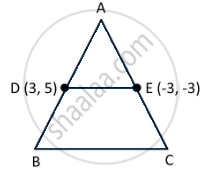Advertisements
Advertisements
प्रश्न
Statement A (Assertion): If the coordinates of the mid-points of the sides AB and AC of ∆ABC are D(3, 5) and E(–3, –3) respectively, then BC = 20 units.
Statement R (Reason): The line joining the mid-points of two sides of a triangle is parallel to the third side and equal to half of it.
पर्याय
Both assertion (A) and reason (R) are true and reason (R) is the correct explanation of assertion (A).
Both assertion (A) and reason (R) are true and reason (R) is not the correct explanation of assertion (A).
Assertion (A) is true but reason(R) is false.
Assertion (A) is false but reason(R) is true.
उत्तर
Both assertion (A) and reason (R) are true and reason (R) is the correct explanation of assertion (A).
Explanation:
Statement A (Assertion): If the coordinates of the mid-points of the sides AB and AC of ∆ABC are D(3, 5) and E(–3, –3) respectively, then BC = 20 units.

We need to use the theorem in Reasoning
The line joining the mid-points of two sides of a triangle is parallel to the third side and equal to half of it.
DE = `1/2` BC
2DE = BC
BC = 2DE
BC = `2 xx sqrt((-3 - 3)^2 + (-3 - 5)^2)`
BC = `2 xx sqrt((-6)^2 + (-8)^2)`
BC = `2 xx sqrt(6^2 + 8^2)`
BC = `2 xx sqrt(36 + 64)`
BC = `2 xx sqrt(100)`
BC = 2 × 10
BC = 20 cm
Thus, Assertion is true.
Statement R (Reason): The line joining the mid-points of two sides of a triangle is parallel to the third side and equal to half of it.
This is always true.
Here is a proof
In ΔABC,
D is the mid-point of AB
⇒ AD = DB
⇒ `(AD)/(DB)` = 1 ......(1)
E is the mid-point of AC
⇒ AE = EC
⇒ `(AE)/(EC)` = 1 ......(2)
From (1) and (2)
`(AD)/(DB) = (AE)/(EC)` .....(If a line divides any two sides of a triangles in the same ratio, 3 then the line is parallel to the third side)
∴ DE || BC
Hence proved
Thus, Reasoning is true.
APPEARS IN
संबंधित प्रश्न
Which point on the x-axis is equidistant from (5, 9) and (−4, 6)?
The coordinates of the point P are (−3, 2). Find the coordinates of the point Q which lies on the line joining P and origin such that OP = OQ.
Find the value of k, if the point P (0, 2) is equidistant from (3, k) and (k, 5).
Find the ratio in which the line segment joining (-2, -3) and (5, 6) is divided by x-axis Also, find the coordinates of the point of division in each case.
If A and B are (1, 4) and (5, 2) respectively, find the coordinates of P when AP/BP = 3/4.
If the poin A(0,2) is equidistant form the points B (3, p) and C (p ,5) find the value of p. Also, find the length of AB.
Show that the following points are the vertices of a square:
A (6,2), B(2,1), C(1,5) and D(5,6)
If the point A(0,2) is equidistant from the points B(3,p) and C(p, 5), find p.
The ordinate of any point on x-axis is
Write the condition of collinearity of points (x1, y1), (x2, y2) and (x3, y3).
Find the values of x for which the distance between the point P(2, −3), and Q (x, 5) is 10.
If the distance between the points (3, 0) and (0, y) is 5 units and y is positive. then what is the value of y?
If A (1, 2) B (4, 3) and C (6, 6) are the three vertices of a parallelogram ABCD, find the coordinates of fourth vertex D.
The distance between the points (a cos θ + b sin θ, 0) and (0, a sin θ − b cos θ) is
If A(x, 2), B(−3, −4) and C(7, −5) are collinear, then the value of x is
Write the equations of the x-axis and y-axis.
If the sum of X-coordinates of the vertices of a triangle is 12 and the sum of Y-coordinates is 9, then the coordinates of centroid are ______
Points (1, –1) and (–1, 1) lie in the same quadrant.
The distance of the point (–1, 7) from x-axis is ______.
